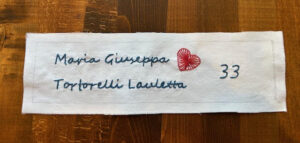by Carolyn Webb

The name I received from Tatter to embroider for the commemoration of the 114th anniversary of the tragic 1911 Triangle Shirtwaist Factory Fire is a beautiful name, the longest on the list of victims: Maria Giuseppa Tortorelli Lauletta. We who volunteered were given the assigned a name and the person’s age at death and given instructions to embroider these on a white fabric 11.5 by 3.5 inches in the colors of the International Ladies’ Garment Workers’ Union.
Embroidering this has been a somber, contemplative experience. Maria was 33 and left behind five children. She came to this country in 1896, and a year later married Egidio Lauletta, also from Italy, who was four years older. A month after the last child was born in 1908, Egidio died, leaving Maria a widow. By the time she died in the fire, three of her children were already in an institution of some kind.
This left one boy (the three institutionalized were also boys) and a girl. After Maria’s death, the fourth boy was sent to be with his brothers, and the girl, Rosina, stayed with the family, which included Maria’s married sister, her younger brother, and the grandparents. A younger sister, Isabella, age 17, was also killed in the fire. Maria and Isabella were one of nine pairs of sisters who perished. The workers were surrounded by heaps of flammable fabrics, pattern papers, open-flame gas lamps, along with the male fabric cutters, who were allowed to smoke.
The factory included three floors: the 8th and 9th floors were the factory, and the 10th was the Triangle Shirtwaist Administration. The workers on the 9th floor were not aware of the fire, which started on the 8th floor. The 8th-floor workers were able to get out, using the elevator (which stopped working), the stairs, and the fire escape. By the time the workers on the 9th floor were aware of the fire, their only escape was the fire escape, which collapsed under the weight of many workers. Of the two hall doors, one led to a staircase that was engulfed in fire, and the other was locked (a common practice, which the owners later denied in court). Some workers leapt down the elevator shaft. For the 62 workers left, the only escape was the windows to the pavement nine floors below. All those in the 10th floor administrative offices escaped, some climbing onto the top of a building next to it.
The Fire Department ladders and hoses reached only as far as the 6th floor, and the nets to capture falling women broke under the weight. One hundred and forty-six people died, 123 women and girls, and 23 men. The youngest was 14.
Maria, her sister Isabella, and five worker’s bodies were unable to be identified and were buried in an unmarked grave. Maria’s parents and another sister put Maria and Isabella’s names on their gravestones. At the 100th anniversary of their burial, Michael Hirsch, a historian, dedicated a granite marker at their final resting place in Evergreen Cemetery.
The Triangle Fire was the worst disaster in New York City until the September 9, 2001, World Trade Center tragedy.
